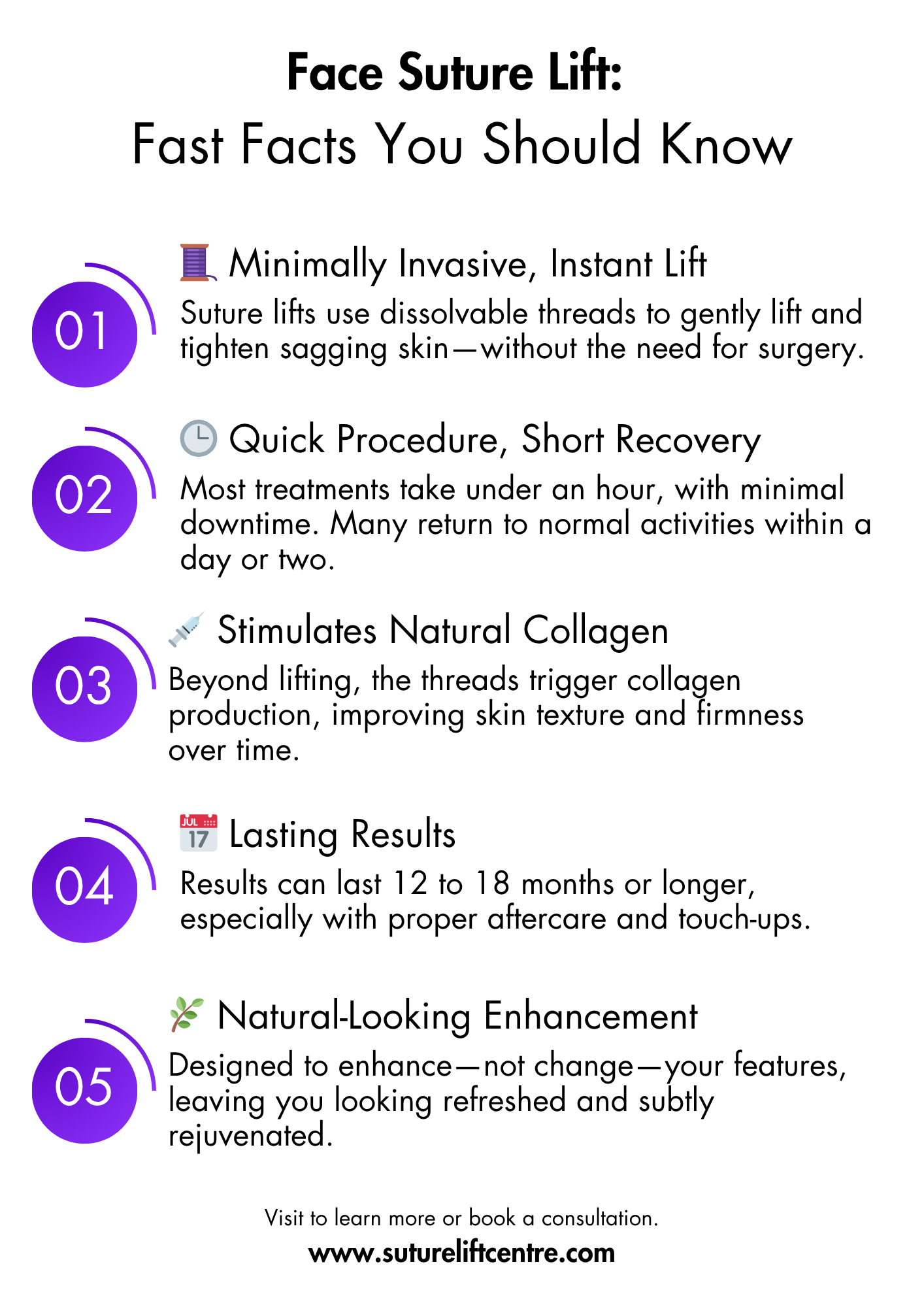When you’re thinking about sprucing up your look without going under the knife, two popular options often pop up: the face thread lift and dermal fillers. Both can help make you look younger, but they do it in different ways and are good for different things. It can be a bit confusing trying to figure out which one is right for you.
This article will help you understand the main differences between a face thread lift vs fillers, so you can make a good choice for your face.
Key Takeaways
- Face thread lifts work by physically lifting sagging skin, while fillers add volume to smooth out wrinkles and lines.
- Thread lifts generally offer a more noticeable lift, great for jowls or a drooping brow, but fillers are better for restoring lost volume in areas like cheeks or lips.
- The results from a face thread lift can last for a good while, often longer than most fillers, but this can vary.
- Recovery from both procedures is usually pretty quick, with minimal downtime compared to surgery.
- Talking to a qualified expert is really important to figure out which treatment, or combination of treatments, will give you the best, most natural-looking outcome.
Understanding Face Thread Lifts

What Is a Face Thread Lift?
Face thread lifts is a procedure designed to lift and rejuvenate your face without going under the knife. Think of it as a less invasive alternative to a traditional facelift. Instead of cutting and removing skin, special threads are inserted under the skin to gently lift and support sagging tissues.
It’s a great option if you’re seeing early signs of ageing and want a refreshed look without significant downtime. It’s all about enhancing what you already have, not drastically changing it.
How Does a Face Thread Lift Work?
It all starts with a consultation to discuss your goals and expectations. Then, during the procedure, the area is numbed with local anaesthetic. After that, tiny entry points are made, and the threads are carefully inserted.
These threads have small barbs or cones that grip the skin, allowing the practitioner to gently lift and reposition the skin. The threads also stimulate collagen production, which helps to improve skin firmness and elasticity over time. It’s a dual-action approach that provides both immediate lifting and long-term rejuvenation.
Benefits of Choosing a Face Thread Lift
Why should you consider a face thread lift? Here are a few reasons:
- Minimally Invasive: No large incisions, less risk of scarring.
- Quick Recovery: Downtime is minimal, so you can get back to your life sooner.
- Natural-Looking Results: Subtle enhancements that refresh your appearance without looking “done.”
- Collagen Stimulation: The threads promote collagen production, improving skin quality over time.
- Longer-Lasting Results: Offers longer-lasting results than fillers.
Face thread lifts offer a refined approach to non-surgical facial rejuvenation. They’re subtle, effective, and often come with fewer surprises than traditional thread lifts. If you’re just starting to explore your options or wondering how to get the most natural results, a thread lift might be the right choice for you.
Exploring Dermal Fillers for Facial Rejuvenation
What Are Dermal Fillers?
Dermal fillers are injectable substances used to restore volume, smooth lines, and soften creases on the face. They’re a popular choice for people seeking a non-surgical way to achieve a more youthful appearance.
It works by adding volume beneath the skin. Most fillers are made from hyaluronic acid (HA), a substance naturally found in the body. HA attracts water, which helps to hydrate the skin and plump up areas that have lost volume due to ageing.
The filler is injected into specific areas of the face to:
- Fill in wrinkles and fine lines
- Plump up sunken cheeks
- Enhance lip volume
- Smooth out acne scars
The effects are temporary, typically lasting from several months to a year or more, depending on the type of filler used and individual factors.
Advantages of Dermal Fillers
Dermal fillers offer several advantages, making them a sought-after treatment:
- Non-Surgical: No incisions or general anaesthesia required.
- Minimal Downtime: Most people can return to their normal activities immediately after treatment.
- Immediate Results: Although some swelling may occur, the effects of fillers are usually visible right away.
- Customisable: Fillers can be tailored to address specific concerns and achieve natural-looking results.
- Reversible: Hyaluronic acid fillers can be dissolved if needed, providing an added layer of safety and control.
Key Differences: Face Thread Lift Versus Fillers
It’s easy to get lost in the world of cosmetic procedures, especially when you’re weighing up a face thread lift against dermal fillers. Both aim to rejuvenate your face, but they go about it in very different ways. Let’s break down the key differences to help you make a more informed choice.
Longevity of Results Compared
One of the biggest differences lies in how long the results last.
- Dermal fillers typically provide results that last anywhere from six months to two years, depending on the type of filler used and how your body metabolises it.
- Thread lifts can offer results that last from 12 to 18 months, although some can last longer. It’s important to remember that neither treatment offers permanent results; both require maintenance to sustain the desired look.
Suture lifts are designed to deliver long-lasting, natural-looking rejuvenation. The procedure uses dissolvable threads that not only lift and tighten the skin but also stimulate collagen production over time. This ongoing collagen boost helps improve skin texture, firmness, and elasticity, supporting a more youthful appearance well beyond the initial lift. With proper aftercare and lifestyle habits, the benefits of a suture lift can be extended significantly.
Mechanism of Action Explained
Fillers work by adding volume to specific areas of the face, plumping up wrinkles and restoring lost contours. They’re great for addressing issues like sunken cheeks or deep nasolabial folds.
Thread lifts, however, work by physically lifting the skin. Threads are inserted under the skin, and then tightened to lift sagging tissues. This not only provides an immediate lift but also stimulates collagen production over time, which can improve skin texture and firmness.
Ideal Candidates for Each Procedure
Choosing the right procedure depends a lot on your individual needs and goals. Fillers are often a good choice for those looking to restore volume and smooth out wrinkles. They’re also suitable for people who want a less invasive treatment with minimal downtime.
Thread lifts might be better suited for those with mild to moderate sagging who want a more noticeable lift without undergoing surgery. Here’s a quick guide:
- Fillers: Volume loss, fine lines, wrinkle smoothing.
- Thread Lifts: Mild to moderate sagging, facial lifting, collagen stimulation.
- Combination: Addressing both volume loss and sagging for a comprehensive rejuvenation.
Ultimately, the best way to decide which procedure is right for you is to consult with a qualified practitioner. They can assess your individual needs and recommend the most appropriate treatment plan. Don’t be afraid to ask questions and express your concerns – it’s all about finding the solution that will help you feel your best.
Recovery and Aftercare for Both Procedures
It’s easy to focus on the procedure itself, but proper aftercare is vital for achieving the best possible results and minimising any potential complications. Let’s look at what you can expect after a thread lift or filler treatment.
Minimising Downtime After a Face Thread Lift
Thread lifts are known for their relatively short recovery periods, which is a big plus for many people. However, following aftercare instructions is key to a smooth recovery. Here’s what you can expect and how to manage it:
- Initial Swelling and Bruising: Expect some mild swelling and bruising for the first few days. Applying cold compresses can help reduce this. Keep your head elevated, especially when sleeping.
- Pain Management: Any discomfort is usually minimal and can be managed with over-the-counter pain relief, such as paracetamol. Avoid anti-inflammatory drugs like ibuprofen unless specifically advised by your practitioner, as they can sometimes increase bruising.
- Activity Restrictions: Avoid strenuous activities, heavy lifting, and excessive facial movements for at least a week. This helps prevent disruption of the threads and allows the tissues to settle.
- Hygiene: Keep the treated area clean and dry. Your practitioner will provide specific instructions on how to cleanse the area gently.
It’s really important to attend any follow-up appointments. These allow your practitioner to monitor your progress and address any concerns you might have. Don’t hesitate to contact them if you experience any unusual symptoms or have questions during your recovery.
Post-Procedure Care for Dermal Fillers
Dermal fillers also have a relatively quick recovery, but there are still some important things to keep in mind to ensure optimal results:
- Immediate Aftercare: Immediately after the procedure, you might experience some redness, swelling, or bruising at the injection sites. Applying a cold compress can help minimise these effects.
- Avoid Touching: Try not to touch or massage the treated area for at least 6 hours after the injections. This prevents displacement of the filler.
- Activity Levels: As with thread lifts, avoid strenuous exercise for the first 24-48 hours. This helps reduce the risk of swelling and bruising.
- Sun Exposure: Protect your skin from excessive sun exposure. Wear a hat and sunscreen if you need to be outdoors.
- Medications: Avoid blood-thinning medications like aspirin unless prescribed by your doctor, as these can increase the risk of bruising.
Managing Potential Side Effects
Both thread lifts and fillers carry some potential side effects, although serious complications are rare. Being aware of these and knowing how to manage them can help ease any anxiety:
- Thread Lifts: Potential side effects include thread migration (rare), infection, visible sutures (usually temporary), and dimpling of the skin. Contact your practitioner immediately if you experience signs of infection (increased pain, redness, swelling, or pus).
- Dermal Fillers: Possible side effects include prolonged swelling or bruising, infection, allergic reaction (rare), and vascular occlusion (very rare but serious). Seek immediate medical attention if you experience sudden vision changes, severe pain, or skin discolouration.
| Side Effect | Thread Lift | Dermal Fillers | Management |
|---|---|---|---|
| Swelling/Bruising | Common, mild | Common, mild | Cold compresses, elevation |
| Pain | Mild | Mild | Paracetamol |
| Infection | Rare | Rare | Antibiotics (prescribed by doctor) |
| Thread Migration | Very Rare | N/A | Removal or repositioning of the thread |
| Vascular Occlusion | N/A | Very Rare | Immediate medical intervention (hyaluronidase injection) |
Remember, open communication with your practitioner is key. They can provide personalised advice and support throughout your recovery journey. Don’t hesitate to reach out if you have any concerns.

Achieving Natural-Looking Results
It’s a common worry: will I look ‘done’? Will I still look like me? The goal with any cosmetic procedure should always be natural-looking results that enhance your features, not erase them. Let’s look at how thread lifts and fillers approach this.
Enhancing Facial Contours with Thread Lifts
Thread lifts are fantastic for subtly redefining your facial contours. The threads gently lift and reposition the skin, creating a more youthful and defined appearance without adding excessive volume.
Because the threads also stimulate collagen production, the results continue to improve over time, blending seamlessly with your natural ageing process.
Subtle Volume Restoration with Fillers
Dermal fillers excel at restoring lost volume in specific areas of the face. The key to natural-looking results with fillers is a conservative approach. Overfilling can lead to a distorted or unnatural appearance.
A skilled practitioner will use fillers strategically to plump up hollows, smooth out wrinkles, and create a more refreshed look, all while maintaining your unique facial features.
Combining Treatments for Optimal Outcomes
Sometimes, the best results come from combining thread lifts and fillers. For example, a thread lift can lift sagging skin along the jawline, while fillers can restore volume to the cheeks.
This combination approach addresses multiple signs of ageing simultaneously, resulting in a more balanced and natural-looking rejuvenation. It’s all about creating harmony and proportion in the face.
Ultimately, achieving natural-looking results depends on choosing a skilled and experienced practitioner who understands facial anatomy and has an artistic eye. They should be able to assess your individual needs and recommend a treatment plan that will enhance your features without making you look like someone else.
Making an Informed Decision for Your Face
Choosing between a face thread lift and dermal fillers is a big decision, and it’s important to feel confident in your choice. It’s not just about chasing a certain look; it’s about understanding what each procedure can realistically achieve for you and your unique facial structure.
Let’s break down the key steps to making the right decision.
Consulting with a Qualified Practitioner
This is, without a doubt, the most important step. A skilled and experienced practitioner can assess your facial anatomy, discuss your goals, and determine whether a thread lift or fillers (or perhaps a combination) is the best approach.
Don’t be afraid to ask questions about their qualifications, experience, and the specific products or techniques they use.
Personalised Treatment Planning
There’s no one-size-fits-all solution when it comes to facial rejuvenation. A good practitioner will take the time to develop a personalised treatment plan that addresses your specific concerns and goals.
This plan should consider factors such as your age, skin type, facial structure, and lifestyle. The plan should also outline the expected results, potential risks, and the cost of the procedure. Remember, the goal is to enhance your natural beauty, not to create a completely different face.
Safety and Efficacy Considerations
It’s really important to think about safety and how well these procedures work before you decide on a face thread lift or fillers. Let’s have a look at what you need to know.
Understanding the Safety Profile of Thread Lifts
Thread lifts are generally considered safe, but like any procedure, there are potential risks. It’s important to be aware of these before proceeding. Common side effects include swelling, bruising, and mild discomfort, which usually resolve within a few days. In rare cases, patients might experience thread migration, infection, or visible sutures.
Choosing an experienced practitioner significantly reduces these risks. They’ll know how to insert the threads correctly and manage any complications that might arise. Also, make sure you follow all aftercare instructions carefully to minimise the chance of infection or other issues.
Assessing the Risks of Dermal Fillers
Dermal fillers are also generally safe, but they come with their own set of potential risks. The most common side effects are similar to thread lifts: swelling, bruising, and redness at the injection site. These usually disappear quickly. More serious, but rare, complications can include allergic reactions, infection, vascular occlusion (where the filler blocks a blood vessel), and nodule formation.
Again, choosing a qualified and experienced injector is key to minimising these risks. They’ll have a good understanding of facial anatomy and use appropriate injection techniques. It’s also important to discuss any allergies or medical conditions you have with your practitioner before getting fillers.
Ensuring a Safe and Effective Experience
To make sure you have a safe and effective experience with either thread lifts or fillers, here are a few things to keep in mind:
- Choose a qualified and experienced practitioner: This is the most important factor in minimising risks and achieving good results.
- Have a thorough consultation: Discuss your goals, medical history, and any concerns you have with your practitioner.
- Understand the procedure and potential risks: Make sure you’re fully informed before making a decision.
- Follow aftercare instructions carefully: This will help to minimise complications and promote healing.
- Set realistic expectations: Both thread lifts and fillers can provide noticeable improvements, but they’re not a substitute for surgery. Having realistic expectations will help you to be satisfied with the results.
Ultimately, the best way to ensure a safe and effective experience is to do your research, choose a reputable practitioner, and follow their advice. By taking these steps, you can minimise the risks and maximise the chances of achieving the results you’re hoping for.
Conclusion
When you’re thinking about a face thread lift or fillers, remember it’s not a one-size-fits-all situation. Both can help you look refreshed, but they do it in different ways and for different lengths of time. The best thing you can do is chat with a good practitioner.
They can look at your face, listen to what you want, and help you figure out which option, or maybe even a mix of both, will give you the results you’re hoping for. It’s all about finding what works for you and your goals.
Frequently Asked Questions
What exactly is a face thread lift?
A face thread lift uses special, fine threads to gently pull up sagging skin, giving your face a subtle lift. These threads are put under your skin and then carefully tightened to lift areas like your cheeks or jawline. It’s a way to refresh your look without big surgery.
How do dermal fillers work to make me look younger?
Dermal fillers are gel-like substances, often made of hyaluronic acid, that are injected into your skin. They work by adding volume to areas that have lost fullness, like deep lines or thin lips. This helps to smooth out wrinkles and make your face look plumper and more youthful.
Which lasts longer, a thread lift or fillers?
Thread lifts tend to last for about 1 to 3 years, as the threads eventually dissolve, though the lift from new collagen can stay longer. Fillers usually last between 6 months and 2 years, depending on the type of filler and where it’s used on your face. Neither is a permanent fix, but they offer good results for a decent amount of time.
Am I a good candidate for a thread lift or fillers?
Thread lifts are great if you have mild to moderate sagging and want a noticeable lift without surgery. Fillers are better for adding volume, smoothing out deep wrinkles, or plumping up areas like lips and cheeks. Your doctor can help you figure out which is best for your specific needs.
What's the recovery like for these treatments?
After a thread lift, you might have a bit of swelling or bruising for a few days, but most people can get back to their normal routine quite quickly. For fillers, downtime is usually very short, often just a day or two of minor swelling or redness. Both are known for having much quicker recovery times than traditional surgery.
Can I have both a thread lift and fillers at the same time?
Yes, it’s quite common for doctors to suggest using both thread lifts and fillers. A thread lift can give a good overall lift, while fillers can then be used to fine-tune specific areas, adding volume where needed. This combined approach often gives the most natural and pleasing results.




